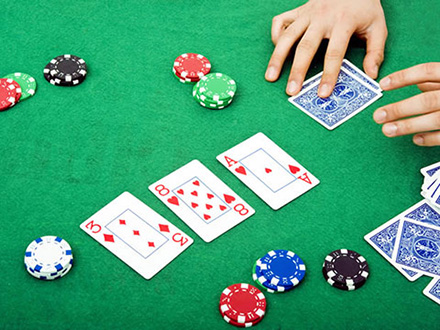Poker strategy: investing to see the flop
Why invest to see the flop in the initial hands, with Bat Bet

- Table type: tournament
- Variant: Texas Hold'em
- Strategy: see the flop trying to get a strong point
- With which hands: 2-2, 3-3, 4-4, 5-5, 6-6, 7-7, 8-8, 9-9
- When: in the initial stages, with low darkness
- With which stack: average of the table
Trying to tie a strong point to the flop by investing little is always a good strategy. When the darkness are low, it is worth it, if you have a Bottom Pair or a Middle Pair.
In the early stages of a tournament, when you have a Middle Pair or a Bottom Pair in hand, the chances of linking a trio to the flop justify the investment of a few additional chips.
At the beginning of each tournament, the dark amount is very low if compared with the initial stack of each player. This situation can be exploited when you have an average couple or a low torque in hand: the expectation to make a trio at the flop is such as to allow a slightly loose game.
The probability of linking a trio to the flop, with a couple in hand, is 12% (about 1 out of 8):
This justifies the investment of a part of your stack, especially if no one relaunches at the table and the only amount to put on the plate is that to call the stuntio. By reasoning mathematically, you could even bet 6% or 7% of your monetary reserves, considering the probability that you have to win the dish.
In addition, having a trio at the flop in most cases puts the player in a clear position of advantage over the opponents. Not only can you beat those who had a higher initial couple or those who have tied a double couple, but it is also possible to exercise strong psychological pressure on opponents who have scale or color projects.
Let's take an example: No Limit Hold'Em table, dark $ 10/$ 20, initial stack $ 1500.
The player A has a hand 9 ♥ 9 ♠.
Player B has a hand Q ♦ 10 ♦.
Player C has a 5 ♠ 5 ♦ hand.
A and B put on the plate respectively dark and stuntule.
Player C is located in the situation described above, and decides to call the counterbuio of $ 20.
In relaunch for $ 40. B decides to call 40 $.
Considering the small investment, C decides not to go, but to call and add another $ 20 to the plate.
We move on to the flop: the cards on the table are 5 ♣ 3 ♠ q ♥.
In this situation, the player C is in clear advantage compared to the opponents: his tris beats the player's couple and that of player B. The player C has a remarkable chance to win the dish and even if obviously he does not know the opponents' cards , the opportunity to remove a high number of chips to players A and B is worth the risk of a part of the stack to continue in hand.
It should be noted that if the situation had not been so rosy to the flop, the player C could have folded and lose only $ 40 out of $ 1500 at his disposal.
(An observation on the possible situations that can occur to the turn and River: if the player's point would be released, he would be higher than that of the player C. The chances that this happens are not negligible, despite the ODDS are in favor of C, therefore attention to the way you intend to proceed in hand.)
Playing in the indicated way can still lead to having a favorite hand even without tieing a trio, as in the situation in which you have a couple 9 ♠ 9 ♣ and at the flop are present on the table 2 ♦ 6 ♥ 7 ♠.











